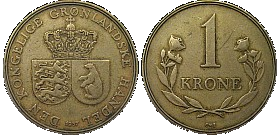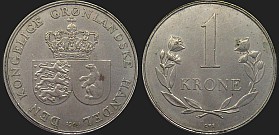GREENLAND (1953-1967) - Greenlandic (Danish) krone [DKK]
1 krone = 100 øre
Innuit, the native people of Greenland did not use the money until the Danes arrived, who began the extraction of mineral resources, and metal. To manage the mining and transport of goods between Denmark and Greenland a state company was appointed called the Royal Greenland Trading Department (Den Kongelige Grønlandske Handel - KGH). The company became the actual administrator of the island and it completely controlled the life of the island. The visits of the KGH ships became more frequent and the opportunities to trade with Denmark arose. In ca. 1860 in the daily exchange of goods appeared the money in a form of tokens produced by different Greenlandic mines. Initially, the tokens were mainly from zinc and very simple, but at the beginning of the 20th century, also well-designed and properly struck tokens appeared. The company Kryolith, Mine Handels-og Selskabet even ordered their tokens at the Royal Mint in Copenhagen. The Danish government noticed that the introduction of money is important for esbalishing the country and in 1926 they produced a relatively huge mass of tokens also for the KGH. These tokens with the Coat of Arms of Denmark on the obverses have dominated the money market in Greenland and have in fact become the currency of the island. The mint in Copenhagen produced the denominations of 25 and 50 øre as well as 1 krone, which corresponded to the Danish krone [DKK] et par. During the occupation of the United States during World War II also coins with face value 5 kroner were produced in Philadelphia without changing the original Danish coin design. Only the Danish regulation of January 16, 1953 sanctioned the KGH's tokens as official currency of Greenland. Interestingly, incorporating Greenland to Denmark took place on June 5, 1953, which questions the validity of the January regulation, but the fact is that since 1953, only the KGH money were circulating in Greenland. In 1957, 1-krone coins were minted, because they were missing on the market. Coins designed by Harold Solomon were initially produced in bronze, but they were quickly brushing off, so subsequent series were prepared in cupronickel. Coins and banknotes of Den Kongelige Grønlandske Handel were withdrawn from circulation on July 1, 1967 and replaced with the relevant denomination of the Danish krone [DKK]. Since then, only this currency is valid on the island. Denmark allowed Greenland to produce local banknotes as those used on the Faroe Islands, but Greenland still has not used this permission.
On today's market one can easily find colourful jetons with issue date 2010 pretending to be coins of Greenland. This rubbish was produced by a private mint Osborne Coinage co., Cincinnati, Ohio, USA ordered by Joseph E. Lang, who proudly puts his initials on these, but also other jetons disguised as coins of the Faroe Islands, Andaman and Nicobar Islands, Cabinda, Western Sahara, Darfur, Easter Island, Kurdistan, Northern Cyprus, Palestine or even Redonda. Thus the businessman focused his activity on territories, from which he does not expect any lawsuits for the production of counterfeit currency.
Please note that currently we are presenting only those two types of circulation coins of Greenland, which were minted after 1944.
coins catalogue :: katalog monet :: münzkatalog :: catalogue de monnaies :: catálogo de monedas :: catalogo monete :: каталог монет :: κέρματα κατάλογος :: COINZ.eu
© 2010-2025 :: Adam Kubicki :: COINZ.eu :: All rights reserved.




